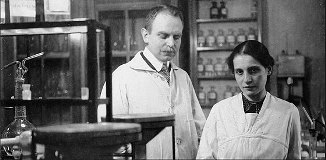Nuclear fission

O. Hahn (left) and E. Meitner (right)
History
In 1938, the German chemists Otto Hahn (1879 - 1968) and Friedrich Wilhelm Strassmann (1902 - 1980) in Berlin discovered that barium was formed when they bombarded uranium with slow neutrons. The Austrian physicists Elise Meitner (1878 - 1968), by then in Sweden, and her nephew Otto Robert Frisch (1904 - 1979) argued that the uranium nucleus had split in two, explained the process and estimated the energy released in the process. Frisch coined the term nuclear fission.In July 1945, the first atomic explosive device, dubbed The Gadget, was detonated in the New Mexico desert. A month later, the Americans dropped such bombs on the Japanese cities of Hiroshima and Nagasaki, killing more than 100,000 civilians.